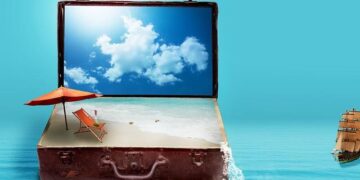Tuna fisheries often rely on fish aggregating devices (FADs), floating human-made structures that fish congregate around, which makes it relatively easy to catch them, but which have also raised concerns about high rates of bycatch, capture of juvenile tuna, and pollution.Despite these concerns, the number of tuna fisheries using FADs that are certified sustainable under the standards of the Marine Stewardship Council (MSC), the largest ecolabeling scheme for wild fisheries, has soared, and FAD-fished tuna now account for more than half of all MSC-certified tuna, according to a new report from France-based nonprofit BLOOM Association.The report contends this constitutes a weakening of MSC standards in order to meet market demands for tuna.The MSC has refuted this claim, pointing to steps that certified fisheries are taking to reduce and study the impact of FADs.
In November 2018, Pesqueras Echebastar, a Spanish tuna fishing company, received a certificate of sustainability from the London-based Marine Stewardship Council, the world’s largest ecolabeling scheme for wild fisheries. This was the first time a purse seine fishery using fish aggregating devices (FADs) — a controversial fishing method — had been certified by the MSC. Since then, the number of MSC-certified tuna fisheries using FADs has soared, according to a recent report by France-based nonprofit BLOOM Association.
“It’s a massive issue because FADs have not become sustainable,” Frédéric Le Manach, BLOOM’s scientific director and the author of the report, told Mongabay in an email. “It’s just the MSC standards and the way they are applied by certifiers that have gotten even weaker.”
The MSC’s senior PR manager, Susannah Henty, disagreed with the report’s findings. “We strongly refute the false and misinformed claims made by Bloom, which has a long running campaign against commercial fishing,” she told Mongabay in an email. “Fisheries obtain MSC certification by meeting a set of strict criteria on their environmental impact — only the highest-scoring fisheries will gain certification … Destructive fisheries cannot be certified as sustainable to the MSC Fisheries Standard.”
 French purse seiner vessel Trevignon hauls a catch of skipjack and yellowfin tuna associated with a fish aggregating device (FAD) in the Mozambique Channel. Image © Jiri Rezac / Greenpeace.
French purse seiner vessel Trevignon hauls a catch of skipjack and yellowfin tuna associated with a fish aggregating device (FAD) in the Mozambique Channel. Image © Jiri Rezac / Greenpeace.
 Three purse seiners docked in American Samoa. Image by Ted McGrath via Flickr (CC BY-NC-SA 2.0).
Three purse seiners docked in American Samoa. Image by Ted McGrath via Flickr (CC BY-NC-SA 2.0).
A magnet for fish
Fishers have long known that fish tend to cluster around floating structures like logs, seaweed, coconuts, and even large animals. They’ve used this knowledge to their advantage, deploying human-made structures known as fish aggregating devices, or FADs, either anchored to the seafloor or drifting, to encourage fish to gather. They then catch the fish using various gear like purse seines, longlines or hooks.
In recent decades, the number of drifting FADs, or DFADs, in the ocean has surged, partly aided by low-cost satellite-tracking buoys that allow fishers to remotely monitor the devices. Tuna fisheries in particular have turned to DFADs because they reduce the time spent searching for tuna. These devices also lead to a much higher fishing success rate for purse seiners compared to using the nets on free-swimming tuna schools. This increased fish catch can help improve food security and revenue for developing countries, according to a review of DFADs published in July.
But there are several concerns too. For example, DFADs tend to catch more juveniles of yellowfin tuna (Thunnus albacares) and bigeye tuna (T. obesus) than when targeting free-swimming schools. This can potentially threaten their populations, researchers say. These devices also tend to result in much higher bycatch of non-target species like sea turtles, sharks and billfishes than does targeting free-swimming tuna schools. Moreover, many of the tens of thousands of these drifting devices get lost, abandoned, or discarded. They often drag mesh nets, which continue to catch marine animals as they float around, and many end up polluting shores.
MSC embraces FADs
The first tuna fishery became MSC certified in 2007. At first, only small-scale, low-impact tuna fisheries were getting the eco-certifications, the BLOOM report notes.
“For consumers, the situation was quite clear until the end of 2011,” Le Manach said. “When buying MSC-certified tuna, you were only buying pole-and-line [or] troll tuna, so, small, coastal fisheries with very low impact gears.”
In December 2011, the Parties to the Nauru Agreement (PNA) fishery — the world’s largest tuna purse seine fishery now comprising eight island states and a territory in the South Pacific — became MSC certified. The fishery catches tuna both from free-swimming schools and by using FADs, but the certification was awarded only to the former part of its operation. At the time, the MSC noted on a webpage about the PNA that “the fishing method behind MSC certified tuna caught in the waters of the PNA nations excludes the use of fish aggregating devices, or FADs … In FAD fishing young tuna can be caught before they can reproduce, with an increased risk of other species ending up as bycatch. Tackling the problems associated with FAD fishing is critical to our ocean’s health and productivity.”
Now, though, industrial tuna purse seine fisheries using FADs account for more than half of all MSC-certified tuna, more than 1.2 million out of 2.2 million total metric tons, the BLOOM analysis found.
 The Spanish Albatun Tres, the world’s largest tuna purse seiner using a fish aggregation device (FAD) near Kiribati. Image © Paul Hilton / Greenpeace.
The Spanish Albatun Tres, the world’s largest tuna purse seiner using a fish aggregation device (FAD) near Kiribati. Image © Paul Hilton / Greenpeace.
 A purse seine net. Industrial tuna purse seine fisheries using FADs account for more than half of all MSC-certified tuna, more than 1.2 million out of 2.2 million total metric tons. Image by Ted McGrath via Flickr (CC BY-NC-SA 2.0).
A purse seine net. Industrial tuna purse seine fisheries using FADs account for more than half of all MSC-certified tuna, more than 1.2 million out of 2.2 million total metric tons. Image by Ted McGrath via Flickr (CC BY-NC-SA 2.0).
“When buying MSC-certified tuna now, you are most likely to buy FAD-caught tuna and tuna caught by a vessel that uses FADs most of its time,” Le Manach said. “You’re very unlikely to find an MSC-certified [tuna] can coming from the earlier small, coastal fisheries with very low impact gears, which have become lost in an ocean of unsustainable fisheries certified along [with] them.”
The MSC’s Henty, however, said it’s “misleading to suggest that all fishing on FADs is destructive.”
To be certified as sustainable, third-party certifiers — chosen and paid by the fisheries themselves — evaluate whether the fishery meets three main principles of the MSC Fisheries Standard: Fishing must be at a level that ensures the target fish stocks are sustainable; it must have low impacts on the wider ecosystem; and the fishery must have effective management that adheres to applicable laws and standards. And to become MSC certified, fisheries must provide “a great deal of data” to the organizations assessing them against the three principles, Henty said.
“In the past, few fisheries using dFADs have been assessed to the MSC Fisheries Standard due to a lack of understanding of the impacts, or high bycatch rates,” Henty added. “However, in recent years … the fishing industry, scientists, regional fisheries management organisations and conservation groups have invested significantly in reducing the environmental impacts of FADs.”
These steps, according to Henty, include improved tracking and data collection, adopting the use of biodegradable FADs, licensing and registration of FADs, using only non-entangling FADs, implementing rapid-release systems to return unwanted catch back to the sea alive, and 100% coverage by independent shipboard observers.
For instance, MSC-certified fishery Echebaster has enacted measures to better track its fleet’s deployed FADs and improve the observer coverage of its fishing trips, and it has committed to using non-entangling and biodegradable FADs. But it has yet to fully adopt these measures. There’s also a lack of consensus on what the best biodegradable and non-entangling FAD designs are. To generate more data, the MSC itself awarded Echebaster nearly 50,000 pounds (about $64,000) in 2020 — two years after its certification — to team up with AZTI, a Spain-based science and technology center, and study some risks posed by derelict DFADs. But in Echebaster’s latest assessment report, the certifying body noted that the research is still a work in progress.
 Tuna cans on grocery store shelves, circa 2008. Image by Daniel Case via Wikimedia Commons (CC BY-SA 3.0).
Tuna cans on grocery store shelves, circa 2008. Image by Daniel Case via Wikimedia Commons (CC BY-SA 3.0).
Two conservation groups raised objections to some of the certifying body’s favorable findings and scores, noting that several DFAD impacts — including how the gear affects species like silky sharks (Carcharhinus falciformis) and the extent and impacts of lost and abandoned DFADs in the ocean — had not been adequately evaluated.
The problem, the BLOOM report contends, is that tuna fisheries using FADs are being MSC certified not because they’re already sustainable at the time of assessment, but because they could be sustainable in the future.
Not everyone shares the MSC’s optimism that this sustainable future will ever arrive.
“My perspective would be that the more we understand about FADs, in fact, the lower they would perform against a sustainability standard,” Megan Bailey, who researches fisheries and seafood supply chains at Dalhousie University in Nova Scotia, Canada, told Mongabay in an email.
“And while it is true that the purse seine industry has invested significant amount of funding to improve FAD designs, the two issues revolving around FAD fisheries have not changed, juvenile overfishing and ecological impacts,” said Bailey, who was not involved in the BLOOM report but has collaborated with the group on research in the past.
The BLOOM report contends that since the MSC charges retailers royalties for using its ecolabel, the organization stands to gain monetarily from increased certification of industrial tuna fisheries. “Retailers are the ones contributing the overwhelming part of the MSC’s budget, but they want big volumes of cheap fish,” Le Manach said. “So, only industrial fisheries work for them.”
This means that consumers wanting to buy sustainable tuna will likely end up buying tuna caught with FADs since that’s most of the certified catch by volume, Bailey said.
“For many consumers that will be fine with them because it carries the blue logo and thus they ‘know’ they are eating sustainable seafood,” she said. “For other consumers, however, they’d likely want to know if what they are buying is actually the ‘best environmental choice’ as the MSC used to proclaim about itself.”
Banner image: Tuna and bycatch on a purse seiner in the eastern Pacific Ocean. Image © Alex Hofford / Greenpeace.
European tuna boats dump fishing debris in Seychelles waters ‘with impunity’
Citations:
Pons, M., Kaplan, D., Moreno, G., Escalle, L., Abascal, F., Hall, M., … Hilborn, R. (2023). Benefits, concerns, and solutions of fishing for tunas with drifting fish aggregation devices. Fish and Fisheries, 24(6), 979-1002. doi:10.1111/faf.12780
Murua, H., Zudaire, I., Tolotti, M., Murua, J., Capello, M., Basurko, O. C., … Santiago, J. (2023). Lessons learnt from the first large-scale biodegradable FAD research experiment to mitigate drifting FADs impacts on the ecosystem. Marine Policy, 148, 105394. doi:10.1016/j.marpol.2022.105394
Christian, C., Ainley, D., Bailey, M., Dayton, P., Hocevar, J., LeVine, M., … Jacquet, J. (2013). A review of formal objections to Marine Stewardship Council fisheries certifications. Biological Conservation, 161, 10-17. doi:10.1016/j.biocon.2013.01.002
Le Manach, F., Jacquet, J. L., Bailey, M., Jouanneau, C., & Nouvian, C. (2020). Small is beautiful, but large is certified: A comparison between fisheries the marine stewardship council (MSC) features in its promotional materials and MSC-certified fisheries. PLOS ONE, 15(5), e0231073. doi:10.1371/journal.pone.0231073
FEEDBACK: Use this form to send a message to the editor of this post. If you want to post a public comment, you can do that at the bottom of the page.
Business, Community Development, Conflict, Conservation, Environment, Environmental Law, Environmental Politics, Fish, Fisheries, Fishing, Food Industry, Governance, Human Rights, Illegal Fishing, Illegal Trade, International Trade, Law, Law Enforcement, Marine, Marine Conservation, Natural Resources, Oceans, Overfishing, Resource Conflict, Saltwater Fish, Sustainability, Tuna
>>> Read full article>>>
Copyright for syndicated content belongs to the linked Source : MongaBay – https://news.mongabay.com/2023/10/report-half-of-msc-certified-sustainable-tuna-caught-with-controversial-gear/































